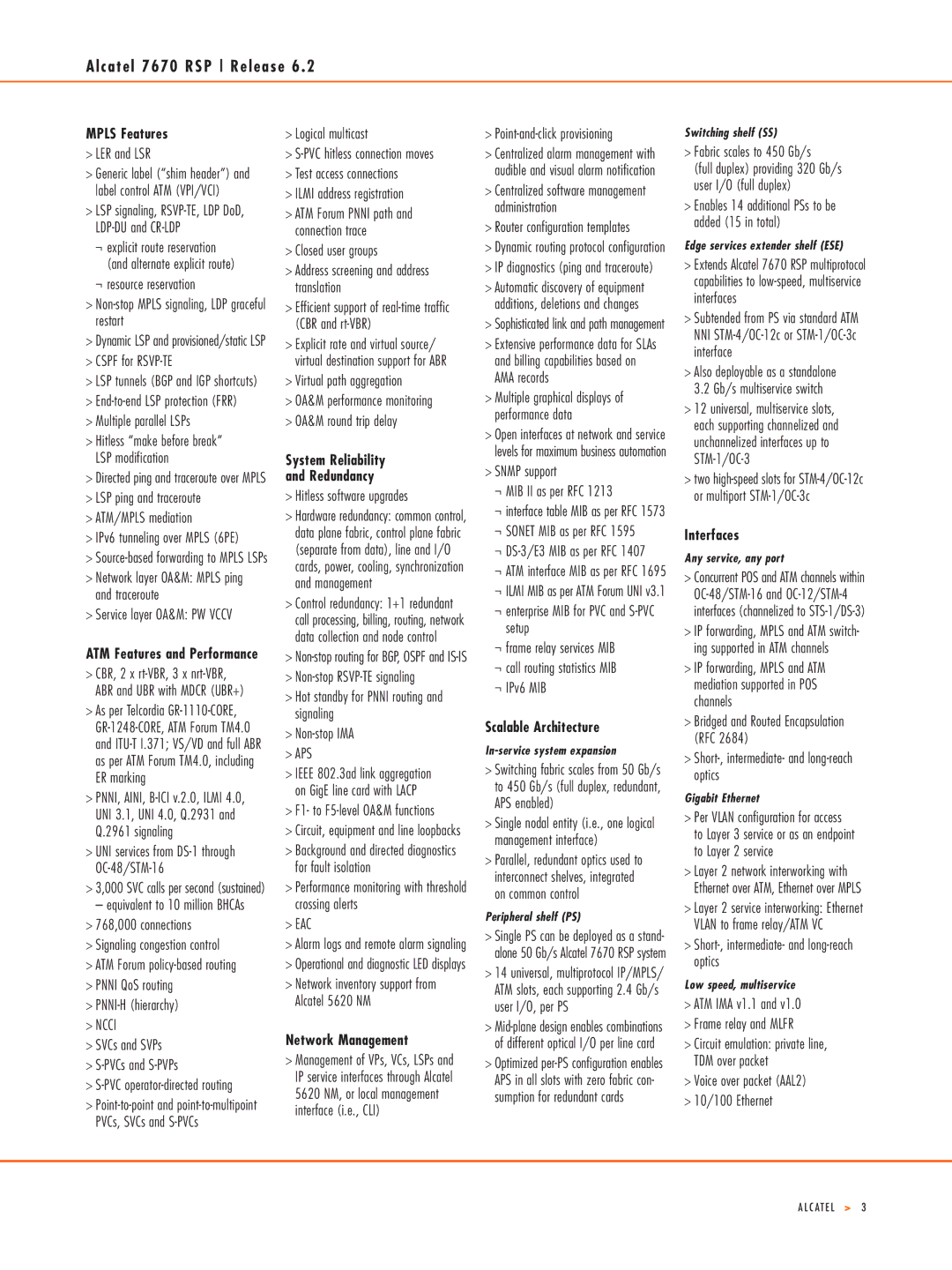
Alcatel 7670 RSP Release 6 . 2
MPLS Features
>LER and LSR
>Generic label (“shim header”) and label control ATM (VPI/VCI)
>LSP signaling,
¬explicit route reservation (and alternate explicit route)
¬resource reservation
>
>Dynamic LSP and provisioned/static LSP
>CSPF for
>LSP tunnels (BGP and IGP shortcuts)
>
>Multiple parallel LSPs
>Hitless “make before break” LSP modification
>Directed ping and traceroute over MPLS
>LSP ping and traceroute
>ATM/MPLS mediation
>IPv6 tunneling over MPLS (6PE)
>
>Network layer OA&M: MPLS ping and traceroute
>Service layer OA&M: PW VCCV
ATM Features and Performance
>CBR, 2 x
>As per Telcordia
>PNNI, AINI,
>UNI services from
>3,000 SVC calls per second (sustained)
– equivalent to 10 million BHCAs
>768,000 connections
>Signaling congestion control
>ATM Forum
>PNNI QoS routing
>
>NCCI
>SVCs and SVPs
>
>
>
>Logical multicast
>
>Test access connections
>ILMI address registration
>ATM Forum PNNI path and connection trace
>Closed user groups
>Address screening and address translation
>Efficient support of
>Explicit rate and virtual source/ virtual destination support for ABR
>Virtual path aggregation
>OA&M performance monitoring
>OA&M round trip delay
System Reliability
and Redundancy
>Hitless software upgrades
>Hardware redundancy: common control, data plane fabric, control plane fabric (separate from data), line and I/O cards, power, cooling, synchronization and management
>Control redundancy: 1+1 redundant call processing, billing, routing, network data collection and node control
>
>
>Hot standby for PNNI routing and signaling
>
>APS
>IEEE 802.3ad link aggregation on GigE line card with LACP
>F1- to F5-level OA&M functions
>Circuit, equipment and line loopbacks
>Background and directed diagnostics for fault isolation
>Performance monitoring with threshold crossing alerts
>EAC
>Alarm logs and remote alarm signaling
>Operational and diagnostic LED displays
>Network inventory support from Alcatel 5620 NM
Network Management
>Management of VPs, VCs, LSPs and IP service interfaces through Alcatel 5620 NM, or local management interface (i.e., CLI)
>Point-and-click provisioning
>Centralized alarm management with audible and visual alarm notification
>Centralized software management administration
>Router configuration templates
>Dynamic routing protocol configuration
>IP diagnostics (ping and traceroute)
>Automatic discovery of equipment additions, deletions and changes
>Sophisticated link and path management
>Extensive performance data for SLAs and billing capabilities based on AMA records
>Multiple graphical displays of performance data
>Open interfaces at network and service levels for maximum business automation
>SNMP support
¬MIB II as per RFC 1213
¬interface table MIB as per RFC 1573
¬SONET MIB as per RFC 1595
¬
¬ATM interface MIB as per RFC 1695
¬ILMI MIB as per ATM Forum UNI v3.1
¬enterprise MIB for PVC and
¬frame relay services MIB
¬call routing statistics MIB
¬IPv6 MIB
Scalable Architecture
In-service system expansion
>Switching fabric scales from 50 Gb/s to 450 Gb/s (full duplex, redundant, APS enabled)
>Single nodal entity (i.e., one logical management interface)
>Parallel, redundant optics used to interconnect shelves, integrated on common control
Peripheral shelf (PS)
>Single PS can be deployed as a stand- alone 50 Gb/s Alcatel 7670 RSP system
>14 universal, multiprotocol IP/MPLS/ ATM slots, each supporting 2.4 Gb/s user I/O, per PS
>
>Optimized
Switching shelf (SS)
>Fabric scales to 450 Gb/s
(full duplex) providing 320 Gb/s user I/O (full duplex)
>Enables 14 additional PSs to be added (15 in total)
Edge services extender shelf (ESE)
>Extends Alcatel 7670 RSP multiprotocol capabilities to
>Subtended from PS via standard ATM NNI
>Also deployable as a standalone 3.2 Gb/s multiservice switch
>12 universal, multiservice slots, each supporting channelized and unchannelized interfaces up to
>two
Interfaces
Any service, any port
>Concurrent POS and ATM channels within
>IP forwarding, MPLS and ATM switch- ing supported in ATM channels
>IP forwarding, MPLS and ATM mediation supported in POS channels
>Bridged and Routed Encapsulation (RFC 2684)
>Short-, intermediate- and long-reach optics
Gigabit Ethernet
>Per VLAN configuration for access to Layer 3 service or as an endpoint to Layer 2 service
>Layer 2 network interworking with Ethernet over ATM, Ethernet over MPLS
>Layer 2 service interworking: Ethernet VLAN to frame relay/ATM VC
>
Low speed, multiservice
>ATM IMA v1.1 and v1.0
>Frame relay and MLFR
>Circuit emulation: private line, TDM over packet
>Voice over packet (AAL2)
>10/100 Ethernet
A L C A T E L > 3
